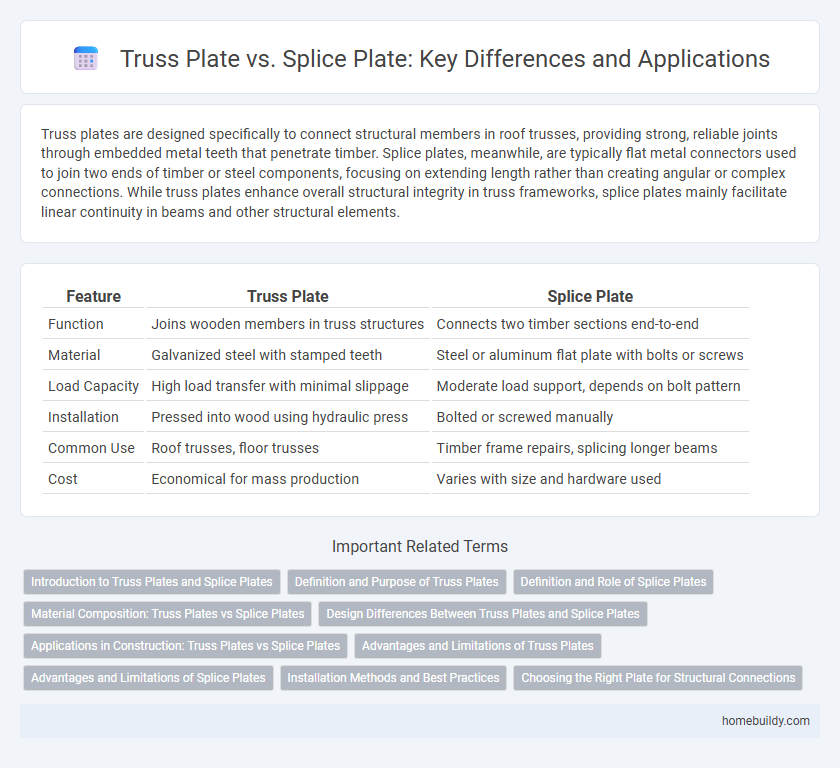Truss plates are designed specifically to connect structural members in roof trusses, providing strong, reliable joints through embedded metal teeth that penetrate timber. Splice plates, meanwhile, are typically flat metal connectors used to join two ends of timber or steel components, focusing on extending length rather than creating angular or complex connections. While truss plates enhance overall structural integrity in truss frameworks, splice plates mainly facilitate linear continuity in beams and other structural elements.
Table of Comparison
| Feature | Truss Plate | Splice Plate |
|---|---|---|
| Function | Joins wooden members in truss structures | Connects two timber sections end-to-end |
| Material | Galvanized steel with stamped teeth | Steel or aluminum flat plate with bolts or screws |
| Load Capacity | High load transfer with minimal slippage | Moderate load support, depends on bolt pattern |
| Installation | Pressed into wood using hydraulic press | Bolted or screwed manually |
| Common Use | Roof trusses, floor trusses | Timber frame repairs, splicing longer beams |
| Cost | Economical for mass production | Varies with size and hardware used |
Introduction to Truss Plates and Splice Plates
Truss plates are metal connectors specifically designed to join wooden members in roof and floor trusses, providing strong, reliable connections through embedded teeth that grip the wood. Splice plates, on the other hand, are used to extend or repair structural elements by joining two pieces of wood end-to-end, often found in beams and columns, ensuring continuity and load transfer. Both plates are essential in timber construction but differ primarily in their application and design to accommodate specific structural needs.
Definition and Purpose of Truss Plates
Truss plates are metal connectors specifically designed to join and reinforce wood truss members by providing strong, reliable load transfer at joint interfaces. Unlike splice plates, which primarily extend or repair wooden beams by overlapping and fastening, truss plates feature multiple pointed teeth that embed into the timber, ensuring a secure and durable connection within engineered wood trusses. These plates play a crucial role in maintaining structural integrity in roof and floor systems by distributing stresses and preventing joint failure.
Definition and Role of Splice Plates
Splice plates are metal connectors used to join two structural members end-to-end, ensuring continuity and load transfer within frameworks. Unlike truss plates, which primarily connect multiple sections of trusses at joints, splice plates focus on reinforcing extended lengths of beams or columns. The key role of splice plates involves maintaining structural integrity by preventing misalignment and enhancing the strength of critical connections in construction.
Material Composition: Truss Plates vs Splice Plates
Truss plates are typically made from galvanized steel with multiple teeth designed for embedding into timber, providing strong connections in wood trusses. Splice plates, often constructed from plain or stainless steel, serve as flat connectors joining two timber members end-to-end and prioritize surface bonding rather than penetration. The material composition differences between truss plates and splice plates influence their mechanical properties, corrosion resistance, and suitability for specific structural applications.
Design Differences Between Truss Plates and Splice Plates
Truss plates are engineered with multiple teeth designed to penetrate and connect wooden members in truss assemblies, providing strong, distributed load transfer across the joint. In contrast, splice plates are typically flat metal connectors used to join two pieces of timber end-to-end, emphasizing alignment and continuity rather than load distribution. The design of truss plates prioritizes rapid assembly and structural rigidity in complex frameworks, while splice plates focus on extending member length with minimal impact on the timber's mechanical properties.
Applications in Construction: Truss Plates vs Splice Plates
Truss plates are primarily used to connect timber members at joints in roof and floor truss systems, offering high-strength, reliable load transfer in prefabricated wooden structures. Splice plates serve to join two timber lengths end-to-end, extending member length or repairing damaged components while maintaining structural integrity. Both plates enhance construction efficiency, but truss plates excel in angular joint connections, whereas splice plates are essential for linear timber extensions.
Advantages and Limitations of Truss Plates
Truss plates offer efficient load transfer and simplified installation in timber connections, providing high strength and corrosion resistance compared to splice plates. Their stamped metal design enables uniform stress distribution, reducing joint failures and enhancing structural integrity in truss assemblies. However, truss plates are limited by their fixed size and shape, making them less adaptable for non-standard connections, and may require precise alignment to maximize their effectiveness.
Advantages and Limitations of Splice Plates
Splice plates offer strong, reliable connections for joining timber elements end-to-end, providing enhanced structural continuity in construction projects. Their advantages include ease of installation and the ability to accommodate various timber sizes, which improves design flexibility compared to truss plates. However, splice plates typically have lower load capacity and less shear resistance than truss plates, limiting their use in applications requiring high strength and stiffness.
Installation Methods and Best Practices
Truss plates require alignment with pre-punched holes to ensure secure fastening using a hydraulic press, optimizing load distribution across timber joints. Splice plates are typically installed by bolting or screwing directly onto timber surfaces, emphasizing precise overlap and clamp pressure for structural continuity. Best practices involve consistent plate positioning, avoiding over-penetration, and verifying connection integrity through visual inspections and load testing.
Choosing the Right Plate for Structural Connections
Truss plates are specifically designed for connecting timber joints in truss structures, offering high strength through their embedded metal teeth, while splice plates primarily serve to join two pieces of timber end-to-end to extend length or repair damage. Selecting the right plate hinges on understanding load requirements and joint types; truss plates excel in resisting shear forces in angled joints, whereas splice plates provide continuity in linear connections. Proper evaluation of structural demands ensures the chosen plate optimizes stability and durability in construction applications.
Truss plate vs Splice plate Infographic

 homebuildy.com
homebuildy.com